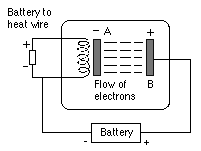|
In the picture tube of a color TV, electrons are accelerated by about 30,000 volts, so that their energy when they hit the screen is about 30,000 ev. That is actually quite a lot: those electrons move at about 1/3 the velocity of light. But then, a TV picture tube is a quite sophisticated instrument. In a doctor's x-ray machine electrons are accelerated to energies 2-3 times higher, after which they hit a target and produce a spray of x-rays.
Particle Energies in Nature
How does nature compare?
- 0.03 ev
- The energy of a molecule of oxygen or nitrogen in the air we breathe. It moves as fast as a speeding bullet, but is still rather low on the scale of energies.
- 0.5 eV
- An atom or molecule at the temperature of the Sun's surface.
- 0.67 ev
- The energy needed by a proton or neutron to escape the Earth's gravity.
- 1000 - 15,000 ev
- Typical energy of an electron in the polar aurora.
- 40,000 ev
- Energy required by an electron to penetrate a thin-wall Geiger counter like that of Explorer 1.
- 50,000 ev
- Typical energy of an ion in the ring current.
Hold it!
We need bigger units:
- 1,000 ev = 1 kev (kilo-electron-volt, pronounced kay-ee-vee)
- 1,000,000 ev = 1 Mev (mega-electron volt or em-ee-vee)
- 1,000,000,000 ev = 1 Gev (giga-electron-volt or gee-ee-vee)
- 1.4 Mev
- The energy of electrons from radioactive potassium, a major source of the Earth's internal heat.
- 4.2 Mev
- The energy of alpha particles from radioactive uranium 238, another source of the Earth's heat (and of its helium as well--see positive ions, history).
- 10-100 Mev
- Typical proton energies in the inner radiation belt.
- 10-15,000 Mev
- Range of energies in solar outbursts (see Sun).
- 1-100,000,000,000 Gev
- Range of energies among cosmic ray ions. However as their energy goes up, their intensity goes way down, so that ions at the high energy end are quite rare.
Note on Relativity
The theory of relativity allows no particle with mass to move as fast as light, but there is no limit on its energy. Close to the speed of light, however, the addition of energy only slightly increases the velocity. An ion accelerating from 0.9 to 0.99 times the speed of light needs several times more energy than the amount it needed to reach 0.9 times in the first place.
Why and How
Where do single electrons and ions acquire such high energies? Excellent question. We guess magnetic and electric fields may be involved, and have learned a great deal in that direction, but the exact processes (probably more than one) remain to be nailed down. Acceleration takes place in solar flares and CMEs (see Sun) but, like a clever conjuring trick, although it happens right in front of our eyes, we still don't get it.
Our best chance may be to study the acceleration of particles in the aurora and radiation belt to more moderate energies, since it occurs in a region of space which instrumented satellites can probe. As we study such acceleration processes we gradually learn how plasmas and magnetic fields interact in space, and that experience can then be applied to the rest of the universe.
|

 Official GSFC Home Page
Official GSFC Home Page  NASA WWW Home Page
NASA WWW Home Page